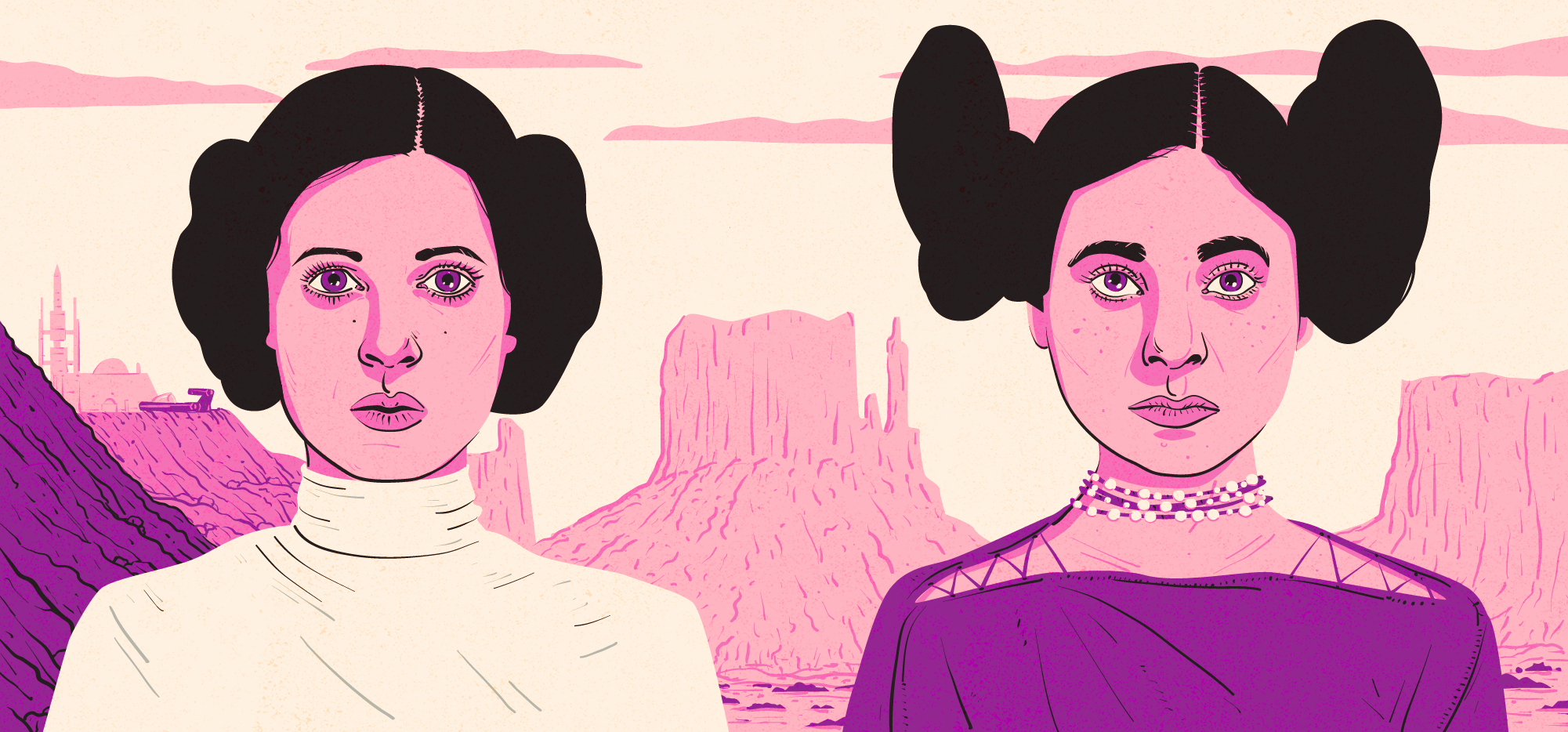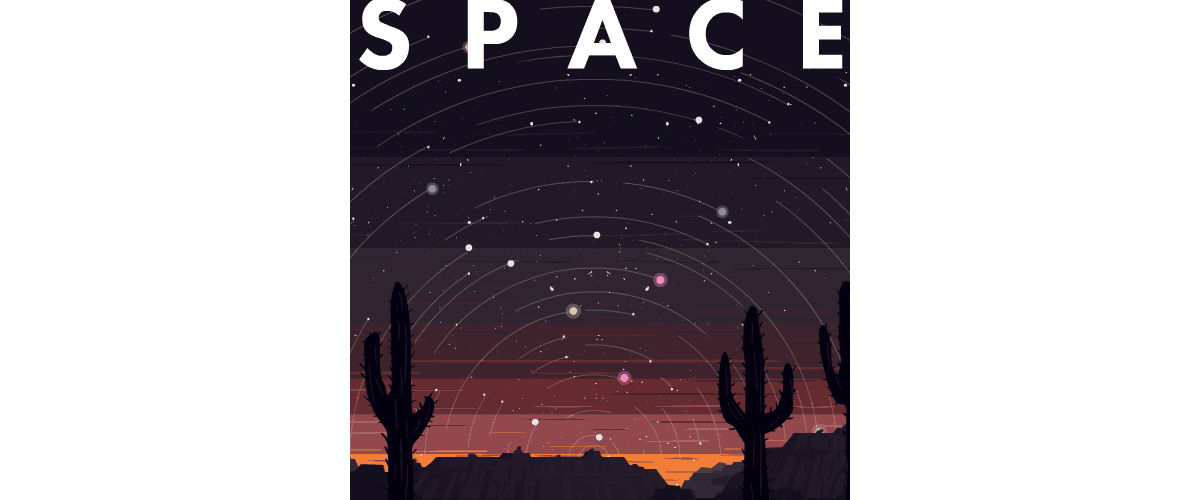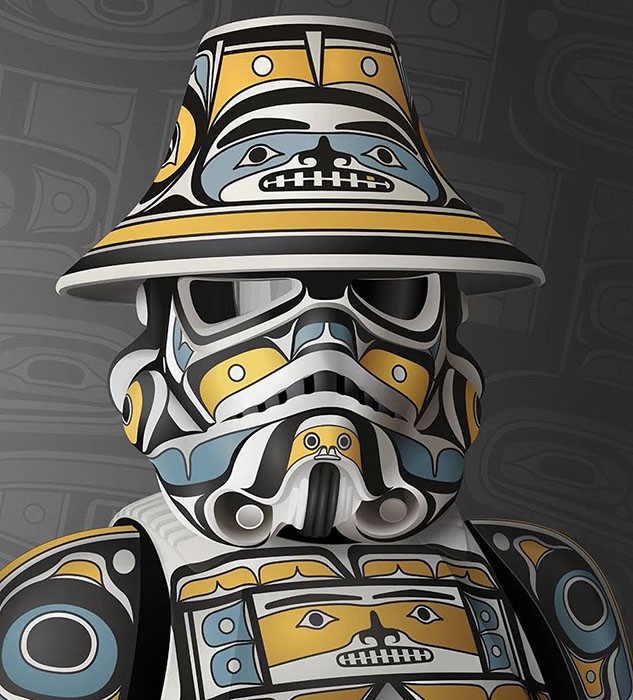

I didn’t live in the first Space Age, but I am here for the sputtering second. A testament to what has stayed the same and what (if very little) has changed between the Cold War of the past and the endless wars of the now, the Star Wars series bridges the two eras. In my own life, I’ve seen it as a universe (though not the cosmic kind) that has been particularly and persistently taken up by Navajo people.
I use the word “Navajo” to describe myself in the same way that I sometimes use the word “gay.” Not because either term is accurate or sui generis–they are not. It is specifically because these are words that, though they don’t really fit, I understand. I don’t really know what it is to be Diné or, rather, what has made my life a Navajo one, except that I have known Navajo people as my family and kin. I have always had a census number on a green piece of paper, a Certificate of Degree of Indian Blood, which officially stamped me. More than that number, it’s Star Wars that confirms my connection to this collective. Our psyches are formed in the shadow of the Death Star, shaped by a history of emerging into (not conquering, not settling) new worlds. We are a space people.
In 2012, Star Wars Episode IV: A New Hope was dubbed in Diné Bizaad and screened at the Navajo Nation Fair in Window Rock, Arizona–the first feature film to ever appear in the Navajo language. Helmed by Manuelito Wheeler, director of the Navajo Nation Museum, the release was heralded as an assertion of linguistic survivance. As a language project, the dubbing reveals both the public orientation and pedagogical possibilities of science fiction. As a moment of cross-cultural encounter between a colonial cultural phenomenon and a people living in conditions of continuing colonial exploitation, it is more complicated. There was, in the translator’s description of the process, the slightest trace of criticism. “We couldn’t translate word for word because Navajo is very descriptive,” Elsa Johnson told Indian Country Today. The script, you see, is sometimes just a little too simple for the world-building of which Navajo is capable.
A lot of what I work on as a scholar on the edges of science fiction and Indigenous studies has developed from trying to understand how to be Indigenous and far from home, and how to understand home as a concept and feeling, as a territory of being rather than borders. That suspended sense of home is one shared across colonial situations. Science fiction makes this suspension a story of suspenseful adventure.
The encounters and influences between Star Wars and Indigenous peoples in particular traffic both ways. The Hopi, for instance, can claim the style of Princess Leia’s signature double bun as adapted from their “squash blossom” style. In the Pacific Northwest, Comox artist Andy Everson of K’ómoks and Kwakwa̱ka̱’wakw First Nations paints stormtroopers–and Darth Vader himself–in the recognizable patterns of the Coast Salish. (Commenting on the unease of “Indigenizing” imperial dress, Everson points to the history of decorating colonial garb with local design.)

Yet because science fiction itself emerges from colonial travel stories, it often revels in imperial fantasies. Even Star Wars, with its scrappy anti-imperial heroes, is constructed entirely from the perceptions, categories, and constructs of the Western subject. Orientalism in the films ranges from Edward Said’s Middle East-centered definition to more East Asian examples, as in the inscrutable, terroristic sand people and all of the obvious Japanese samurai and kung fu movie influences. There is also the pop-psych meta-text, Joseph Campbell’s work of comparative mythology The Hero with a Thousand Faces, to give Lucas’ sketchy characterizations anthropological heft.
Star Wars resonates for Navajos in part because one of the only ways we have to understand our world(s) is through war. Watching Star Wars for an Indian is not unlike listening to country music, including the discomfort when singing along feels like singing with and for the Country, the United States. But space opera and the NDN country canon (Hank Williams, Patsy Cline) are all about expansive emotions, the black hole of longing, the void at the end of loss, the force of life continuing. To walk with Patsy and Hank is not to repair the country or its epics but, rather, to take them up in order to prefigure a world in which their transformation can be completed.
In his 1977 review of A New Hope (for which he received two pounds of hate mail), Samuel Delany deftly describes the pleasures of watching a film that manages to be both an “imaginative failure” and “a delight.” For Delany, the movie is all about motion and size, the sensorial complexity of a world of worlds –even if that complexity is never actually delivered. Now, more than 40 years later, there have been seven more Star Wars movies (plus the TV series and spin-off flicks, and works in other media). In 2015, Delany’s views on the mythology, published on Facebook under the title “THE FORCE WAKES, ONCE MORE CANNOT QUITE BRING ITSELF TO LOOK AT WHAT’S GOING ON OUT IN THE THEATRE, SO ROLLS OVER AND DRIFTS OFF,” have grown more frustrated.
Both The Force Awakens and The Last Jedi cast a multiculti galaxy, but this is a performance of plurality without the actual world-building necessary to explain and sustain difference. In his other writings on the SF genre, Delany extols the suggestiveness of sci-fi, drawing attention to the imaginative effort that has to be expended by the reader or viewer to complete the work. Star Wars, in this way, is a narrative fixer-upper. Its suggestive structures are so lacking in their particulars that those who watch and want more from the stories can take the narrative up into their own modes of imaginative production.
If science fiction’s aim is to estrange, does a Navajo rendering of the Star Wars universe make strange the strange? Can this reappropriation ever be seen by the outside? In 2012, my friend showed me Nanobah Becker’s short film The 6th World. I experienced its 15 minutes as the merging of my two creation stories: the Diné Bahaneʼ and the world-famous interstellar blockbuster. In Becker’s film, a Diné woman travels to Mars as part of a research initiative to colonize the planet. She has with her an ear of ancestral corn, which, it is suggested, will be what allows for the cultivation of life–as opposed to the sterile lab corn defended by the white scientist of the movie. He dies.
A creation story has to be told over and over again. Reshaping, painting over, literally revoicing the narratives of empire and democracy, Indigenous–and specifically Navajo–transfigurations of Star Wars take us through the complexities of reordering the world and cosmos, even if we cannot escape the paradoxes entirely. Domed settlements and corn crops appear in a red dirt landscape against a red sky at the end of The 6th World: a vision of Mars shot in Monument Valley, on the Navajo reservation.


How We Get To Next was a magazine that explored the future of science, technology, and culture from 2014 to 2019. This article is part of our “Space” Beat, which asks: If humans are to leave Earth and become an interplanetary species, whose vision of the future will be realized? And who will get to be a part of it? For more dispatches, click the logo.
